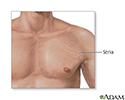Stretch marks
Striae; Striae atrophica; Striae distensae
Stretch marks are irregular areas of skin that look like bands, stripes, or lines. Stretch marks are seen when a person grows or gains weight rapidly or has certain diseases or conditions.
The medical name for stretch marks is striae.
Considerations
Stretch marks can appear when there is rapid stretching of the skin. They are often seen when a woman's abdomen gets larger during pregnancy. They can be found in children who have become rapidly obese. They may also occur during the rapid growth of puberty in males and females. Striae are most commonly located on the breasts, hips, thighs, buttocks, abdomen, and flank.
Stretch marks appear as parallel streaks of red, thinned, glossy skin that over time become whitish and scar-like in appearance. The stretch marks may be slightly depressed and have a different texture than normal skin.
Stretch marks may also occur as a result of abnormal collagen formation, or a result of medicines or chemicals that interfere with collagen formation. They may also be associated with longtime use of cortisone compounds, diabetes , Cushing disease, and post-pregnancy.
Diabetes
Diabetes is a chronic disease in which the body cannot regulate the amount of sugar in the blood.

Causes
Causes may include any of the following:
-
Cushing syndrome
Cushing syndrome
Cushing syndrome is a disorder that occurs when your body has a high level of the hormone cortisol.
 ImageRead Article Now Book Mark Article
ImageRead Article Now Book Mark Article - Ehlers-Danlos syndrome
- Pregnancy
- Puberty
-
Obesity
Obesity
Nearly 2 out of every 3 adults in the United States are overweight.
 ImageRead Article Now Book Mark Article
ImageRead Article Now Book Mark Article - Overuse of cortisone skin creams
Home Care
There is no specific care for stretch marks. Marks often disappear after the cause of the skin stretching is gone.
Avoiding rapid weight gain helps reduce stretch marks caused by obesity.
Weight gain
Unintentional weight gain is when you gain weight without trying to do so and you are not eating or drinking more.

When to Contact a Medical Professional
If stretch marks appear without clear cause, such as pregnancy or rapid weight gain, call your health care provider.
What to Expect at Your Office Visit
Your provider will examine you and ask about your symptoms, including:
- Is this the first time that you have developed stretch marks?
- When did you first notice the stretch marks?
- What medicines have you taken?
- Have you used a cortisone skin cream?
- What other symptoms do you have?
If the stretch marks are not caused by normal physical changes, tests may be done. A retinoid cream can be prescribed and may help reduce stretch marks. Laser treatment may also help. In very rare cases, surgery may be done.
References
Emer JJ, Khorasani H. Striae. In: Lebwohl MG, Heymann WR, Berth-Jones J, Coulson I, eds. Treatment of Skin Disease: Comprehensive Therapeutic Strategies . 4th ed. Philadelphia, PA: Elsevier Saunders; 2014:chap 226.
-
Striae in the popliteal fossa - illustration
Striae in the popliteal fossa: Striae or stretch marks result from stretching of the skin, or other influences such as Cushing's syndrome. Most pregnant women experience striae at some point during their pregnancy. This picture shows striae in the popliteal fossa (the area on the back side of the leg at the knee joint). When the striae first appear they have a violaceous (red-purple) color, but over time they take-on a dull white appearance.
Striae in the popliteal fossa
illustration
-
Striae on the leg - illustration
Stretch marks (striae) result from rapid stretching of the skin which may occur with obesity, pubertal growth spurts, pregnancy, or from other influences such as Cushing syndrome.
Striae on the leg
illustration
-
Stria - illustration
Stretch marks (striae) can appear when there is rapid stretching of the skin. Stretch marks appear as parallel streaks of red, thinned glossy skin that over time become whitish and scarlike in appearance. They are often associated with the abdominal enlargement of pregnancy and can also occur during the rapid growth of puberty in males and females. The stretch marks may be slightly depressed and have a different texture than normal skin.
Stria
illustration
-
Striae in the popliteal fossa - illustration
Striae in the popliteal fossa: Striae or stretch marks result from stretching of the skin, or other influences such as Cushing's syndrome. Most pregnant women experience striae at some point during their pregnancy. This picture shows striae in the popliteal fossa (the area on the back side of the leg at the knee joint). When the striae first appear they have a violaceous (red-purple) color, but over time they take-on a dull white appearance.
Striae in the popliteal fossa
illustration
-
Striae on the leg - illustration
Stretch marks (striae) result from rapid stretching of the skin which may occur with obesity, pubertal growth spurts, pregnancy, or from other influences such as Cushing syndrome.
Striae on the leg
illustration
-
Stria - illustration
Stretch marks (striae) can appear when there is rapid stretching of the skin. Stretch marks appear as parallel streaks of red, thinned glossy skin that over time become whitish and scarlike in appearance. They are often associated with the abdominal enlargement of pregnancy and can also occur during the rapid growth of puberty in males and females. The stretch marks may be slightly depressed and have a different texture than normal skin.
Stria
illustration
Review Date: 4/14/2015
Reviewed By: Kevin Berman, MD, PhD, Atlanta Center for Dermatologic Disease, Atlanta, GA. Review provided by VeriMed Healthcare Network. Also reviewed by David Zieve, MD, MHA, Isla Ogilvie, PhD, and the A.D.A.M. Editorial team.



